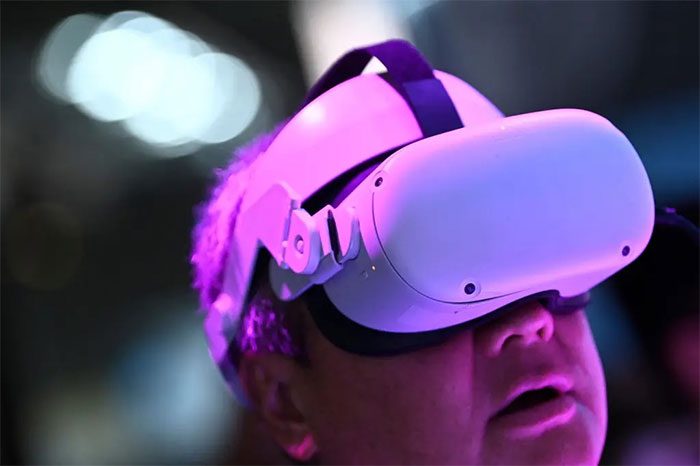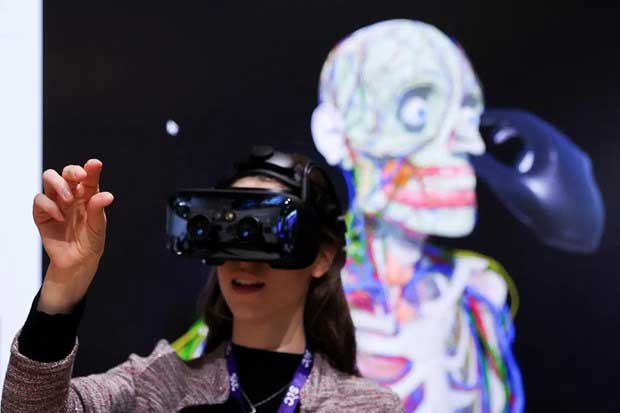Scientists are focusing on developing virtual reality technology that allows users to not only perceive a three-dimensional environment through sight but also through smell.
According to a scientific study published last week in the journal Nature, engineers from Beijing University of Aeronautics and Astronautics and the University of Hong Kong have created a special virtual reality (VR) headset.
This headset enables users to smell 30 different scents, including coffee, alcohol, and pancakes.

New technology provides a more realistic experience for virtual reality device users. (Photo: AFP).
“Recent human-machine interfaces have highlighted the importance of sensory feedback from human perception, such as vision, hearing, and touch, in entertainment, medical treatment, or VR/AR (augmented reality),” the research team stated.
“Olfaction plays a significant role in human cognitive experiences, and it is just as important as auditory and visual feedback.”
The breakthrough technology that the team is researching involves using heated electrodes to melt small pieces of paraffin wax containing fragrance to create smells. These new scent-producing devices are also referred to as OG. They will be positioned right under the user’s nose during the experience.
The team has also proposed a new design for a VR headset that fully encloses the user’s face. This new design aims to replace outdated scent-producing technology.
Older scent technologies relied on bulky liquid fragrance bottles, complex accompanying wires, or other primitive scent generation functions.
The research suggests that the OG scent devices could be used not only in virtual reality games but could also enhance the experience of remote classrooms.
Engineers also promise that this device could help patients with dementia recover memories.
Additionally, the team noted that some scents produced by the OG device could be used to soothe users’ emotions.
Since scents can evoke human emotions by recalling poignant memories, OG could also be used to help alleviate stress and depression in users.
The engineers are working towards miniaturizing the overall size of the OG to prolong the scent duration and reduce latency when users switch between different scents.
Last year, OVR Technology, a virtual reality technology developer from the United States, also drew attention when they announced a method for creating scents in virtual spaces.
The company introduced a VR headset along with a scent generator, which is housed in a white box called ION. When users approach an object in the virtual space, such as a strawberry, they will smell the strawberry scent emanating from ION.
According to OVR, the ION box has 9 chemical compounds available, which can be mixed together through pre-programmed signals to create hundreds of different scents.
OVR views the integration of smell into virtual spaces as key to the future digital world.
OVR’s CEO, Aaron Wisniewski, stated that scent will be an important part of developing the virtual metaverse, being one of the main factors affecting human sensation.

A user experiencing a VR headset. (Photo: Reuters).
In 2017, the Japanese company VAQSO also created a device named VAQSO VR designed to be attached to popular VR headsets at the time, such as Oculus Rift, PlayStation VR, Gear VR, and HTC Vive.
Specifically, VAQSO VR is a device that generates scents corresponding to the experiences users have while wearing VR glasses. For instance, while playing a 3D game, users might smell gunpowder during a battle or the scent of foliage while walking through a forest.
The VAQSO device connects to third-party VR headsets via micro USB or Bluetooth. It is semi-circular, fitting around the user’s face.
The device contains five replaceable scent cartridges, with each cartridge holding one of 15 fragrance oils provided by the company.
When activated by codes in the VR game being played, the device selectively releases scents from the fragrance cartridge. These scents relate to what is happening in the game.
VAQSO claims that their device can produce scents like “zombie,” in addition to other scents including ocean, burning fire, gunpowder, forest, wood, earth, coffee, caramel, chocolate, curry, fried chicken, mint, gas, flowers, and perfumes.
The company can also create custom scents upon request from corporate clients at a cost of about 3,000 USD per scent.


















































